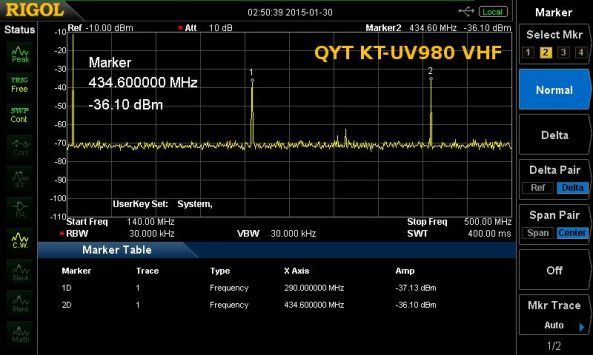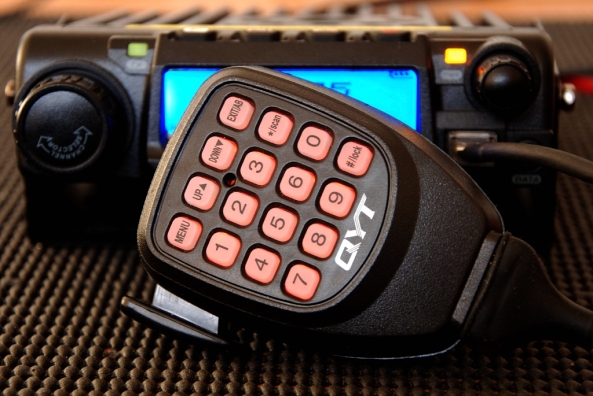A while ago I got my hands on the QYT KT-UV980 dual-band mobile. The enclosure suggested that I was dealing with a new Anytone variety, but equipped with one VFO instead of two independent VFOs. Switching between VHF and UHF is done with the A/B button, or automatically when you switch on Dual Watch – a bit like a Baofeng UV-5R.
Speaking of Baofeng: the menu isn’t too different from a UV-5R either, up to selecting the three background colors. That came in handy, because my sample didn’t come with a manual, nor with software. There are differences too: contrary to a UV-5R you can program everything manually, up to the alpha tags. Display choices are frequency, channel number, and channel name.
Changing something is easy: press F(unction), use the channel selector to select a menu option, press Function again, change the setting, press F to save your settings and press the Exit button to quit.
First impressions
As said before, the QYT KT-UV980 looks a lot like the Anytone AT-588 mono-band transceiver. During the test it became clear that Anytone is probably not the driving force behind this design, as the radio has faults not seen in Anytone models for a long time.
The RJ-45 microphone connector is compatible with Kenwood. The microphone itself is too, but up to a point. PTT, TX audio and up/down will work, keying in a frequency too, but the special keys are not easy to replicate.
Inside the radio
This radio is not as neatly built as the latest Anytones. There are quite a few last minute modifications visible, soldering looks a bit sloppy here and there, and two red-colored wires connecting ‘something’ in the front panel to PCB ground.
Transmitter
According to the specs this radio should deliver 40/10 Watts on VHF and 30/10 Watts on UHF. These factory specs weren’t far off on VHF, but on UHF it’s a different story. Measurements done @ 145 MHz and 435 MHz.
VHF High: 42 Watts, VHF Low: 7.0 Watts.
UHF High: 14.5 Watts, UHF Low: 6.2 Watts.
That’s quite a gap between those promised 30 Watts and measured 14.5 Watts. In order to make sure the radio wasn’t messed up in some way I did a full reset, checked the Watt meter once more, and checked the working voltage. All to no avail. There’s no service menu (or I couldn’t find it), and there isn’t any TX power control on the PCB either.
The transmitter has some trouble starting up when you press the PTT button; there’s a short squeaking sound which will fade away in about half a second. It looks and sounds like an oscillator having trouble to get stable.
TX audio
Well, that sucks. I had more or less to yell in order to get my message across, and the tonal quality is typical ‘Chinese Disease’: no highs, no real lows, and lots of mid tones. When I replaced the QYT microphone by the one supplied with the Kenwood TMV-71 my TX audio got a lot better.
Harmonic suppression
I quickly found out that the QYT KT-UV980 isn’t easy to measure. Sometimes the radio became unstable, which resulted in weird results on the spectrum analyzer — lots of peaks, even at places in the spectrum where they didn’t make any sense at all. The results below are ‘best case scenarios’ of sorts, but I still have my doubts.

 Receiver
Receiver
As usual with modern designs you can’t complain about sensitivity, with -127 dBm on VHF and -125 dBm on UHF this radio is as sensitive as they come.
Also as usual the weakest link in the chain is the way a radio handles strong out-of-band signals. While the QYT KT-UV980 is way better than the Leixen VV-898 and even outperforms the Kenwood TMV-71E, there’s still room for improvement. Especially on UHF (the most challenging band here) there’s a slight haze of noise draped over even the strongest signals. The noise only disappears when I have the antenna signal running through a tunable band filter.
RX Audio
RX audio sounds fine, the volume can be very high without a hint of distortion. Excellent. There’s a mysterious problem though which has something to do with the electronics in the microphone. When you turn the volume completely down on an active frequency, there’s a buzzing sound audible in the speaker. If the frequency is empty, the buzzing sound is absent.
It didn’t matter if I used the QYT microphone or a Kenwood microphone. With a desk microphone (with no other controls than PTT and a pot to set the audio level) the problem was gone too. When you remove the microphone completely, you won’t hear the buzzing sound either.
The problem probably won’t bother you much when you use the QYT in a car; as soon as you set the volume to a comfortable level you won’t notice it. Whatever the cause, it’s a sign of a sloppy design.
Conclusion
$151 (409shop) isn’t much for a full featured dual-band mobile, but don’t expect much either. The tested QYT KT-UV980 has quite a few flaws and quirks, and factory specs prove to be a bit optimistic. I’m not sure if all these problems are just plaguing my sample, but for new buyers I sure hope that’s the case. Please let me know if you get one.
The radio came to life a bit after I started to use a ‘dumb’ but good sounding desktop microphone. It’s actually a usable radio now, but not more than that.



